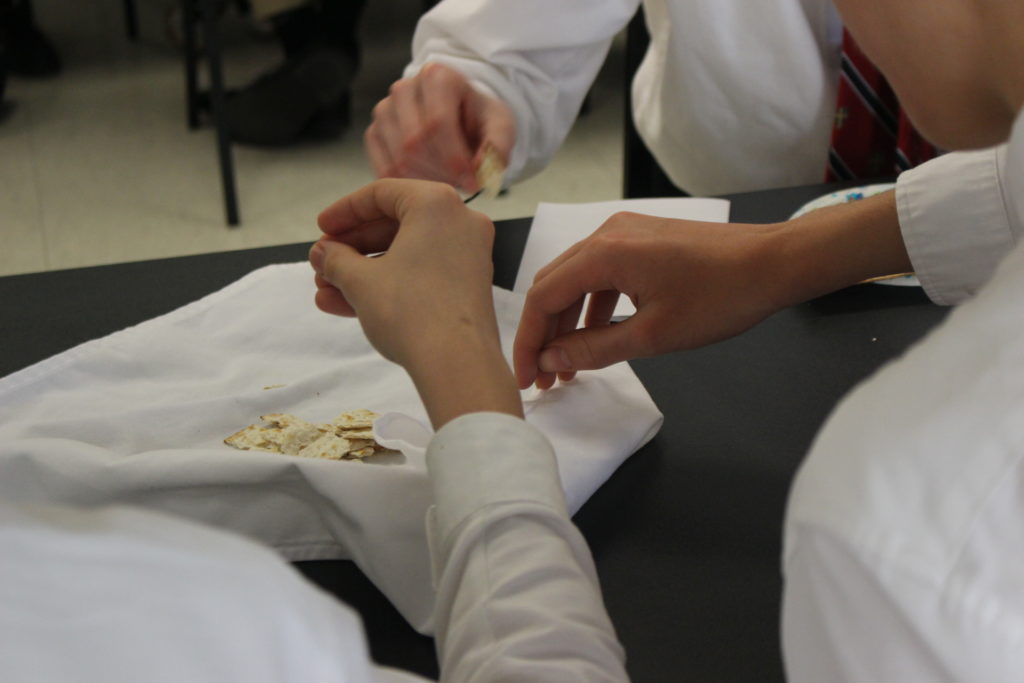Passover Seder
4/19/19
This year the 9th grade class participated in a Passover Seder, hosted by Cambridge parents Mr. & Mrs. Pikman. You can read Dr. Isbell’s post on last year’s Passover Seder here. The students tasted the bitter, sweet, and salty elements; joined in the ritual blessings; and sang Hebrew songs such as “Dayenu” (“We Would Have Been Satisfied”). Here are some of the students’ reflections:
Jack Jackson – “The first thing I got from the [Passover] experience was how family-oriented it seemed, and how well it balanced the solemn with the joyous. Traditions like the children and the father playing hide and seek with a central and prophetic piece of the Seder seemed to me like a really great way of balancing that which carries on tradition, with a thing which all generations can really enjoy. Other pieces of the Seder like the question and response portion of the meal which brought the youth into the dinner also seemed to point to a great way of preserving the right attitude of joy and awe. I also appreciated the way in which the elements of the feast resembled the Biblical account of the Last Supper. That is to say, I found that parts of the story that had only seemed to me like parts of a normal dinner were actually parts of the Passover structure. Things like the bowl in which Judas had dipped his hand that singled him out now made sense in the context of the Seder. The washing of the feet that Mr. Pikman pointed out took on new meaning as well, in that it was not part of the Passover supper generally, and so Jesus’ extraordinary display of humility seemed all the more humble of him in the new context.”
Allison Peterman – “The insight Mr. Pikman gave into the Seder as it tied into and alluded to the coming Messiah was fascinating. Almost everything meant something related to the Messiah. The lighting of the candles signifies Christ the Light of the world; the middle matzah being broken, hidden, and brought back again symbolizes the death, burial, and resurrection of Jesus. The Passover lamb, which is no longer served, also symbolizes Jesus, who shed his blood for the salvation of many, just like the lamb’s blood was shed so that the firstborn Israelites would not be killed. The Cup of Redemption also plays an important role because that is what becomes the Blood of Christ, as is the means by which we are redeemed. The matzah that is broken is also important because it becomes the Body of Christ, broken for the sins of the world.”
Raymond Harrison – “The Passover meal was really cool, especially learning about how every single piece of food on the table represented something important, and the order of the meal is also special. The way the meal points to Christ is also incredible, especially in the way of showing his suffering and hope for his return.”
Clare Northrop – “During the Passover meal one of the primary things that I learned was the purpose of the Karpas [parsley] dipped in salt water…. The Karpas represents the hyssop that was used to spread the blood of the lamb on the doorpost to protect the first born children from the angel of death and the salt water that the Karpas was dipped in was to represent tears of anguish by the Jewish people while they were still in captivity.”
Charles Bruce – “What is beautiful about this scene is that the Passover meal directly describes what happens to Jesus and the disciples. Jesus’ body is broken (not bones, just other wounds), and He shed His blood for all of us, just like He said would occur. In addition, He was the fulfillment of the perfect lamb that had been used in Egypt, as He was better in every way, as His death was used to save all of humankind, instead of just the Israelites.”
